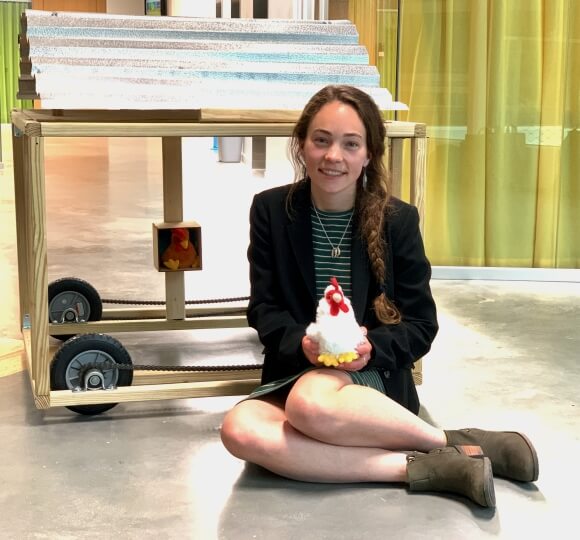Ursula Volz, S.B. '22, designed a solar-powered autonomous mobile chicken coop for her senior capstone project. (Credit: Matt Goisman/SEAS)
Engineering Design Projects (ES 100), the capstone course at the Harvard John A. Paulson School of Engineering and Applied Sciences, challenges seniors to engineer a creative solution to a real-world problem.
The Running Chick-Inn: A Mechanical Chicken Coop
Ursula Volz, S.B. ‘22, mechanical engineering
Where’d your project idea come from?
Chickens raised on factory farms are subject to brutal, unhealthy conditions, which in turn leads to unhealthy eggs for human consumption. Raising chickens in your backyard is a way to get fresher, healthier eggs. My family has always wanted chickens, but we haven’t been able to get them because they can destroy a yard. My mobile coop makes it easier for chickens to spread their feeding over an entire yard, improving it through their nitrogen-rich droppings that act as a natural fertilizer.
How does your coop work?
Solar panels on the roof power the motors and drivetrains for the wheels, while ultrasonic sensors detect obstacles in the yard to navigate around them. My coop can support up to six chickens, and features nesting boxes, perches and an egg run to collect the eggs. The model is scalable for differing numbers of hens as well.
How did your project come together over the course of the year?
My first computer-aided design (CAD) model was done right before winter break, so I spent a lot of the fall working on that. When I put together that CAD model, I didn’t have any ideas for which components exactly I would put in it. The next couple months were me really dialing down which components exactly would go in it, and then making a CAD model to make sure that everything fit together the way that I wanted it to. The build only took me the last couple weeks after I’d gone through and made sure all the components would work.
What was the most challenging part?
The project that I’d laid out required pretty high-torque motors, which are pretty hard to find for a low cost. I spent a lot of time researching motors that could potentially work, and having no luck. That was the main hurdle for me, finding a motor that I thought would work, and even so it didn’t do everything that I wanted it to do. When I first connected them to power, the current spiked and it didn’t move. But then when I looked at the side of it, the drivetrain was spinning, so I realized that it did work. From that point I was just trying to figure out exactly how much weight it could move with the motors that were on it. But when the coop finally moved, it was a very big moment.
What part did you enjoy the most?
The construction was the most satisfying part, because I had worked really hard to come up with the right components and map it out correctly. When I did connect it to power and it finally moved, it was like this ‘Aha!’ moment that was very exciting.
What skills did you gain through your project?
A big thing for me was being able to work with a physical build in a lab, and being able to take the knowledge that I had learned in my classes so far and apply it to something that was so hands-on. That’s what I always pictured engineering to be, being able to apply everything you learned. This project allowed me to do that, and I learned a lot from the experience.
Press Contact
Matt Goisman | mgoisman@g.harvard.edu
